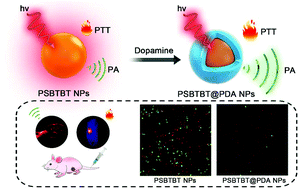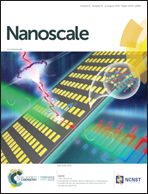Mussel-inspired functionalization of semiconducting polymer nanoparticles for amplified photoacoustic imaging and photothermal therapy†
Abstract
A versatile and straightforward strategy for the encapsulation of semiconducting polymer nanoparticles (SPNs) using biocompatible polydopamine (PDA) as both the protection and versatile bioconjugation layer is proposed. In addition to providing stable functionalized SPNs, this approach provides SPNs with a flexible surface for further modification with various functional ligands. In this study, three representative surface modifiers including a small molecule (folic acid, FA), a peptide (cRGD) and a stealth polymer (SH-PEG) were conjugated onto the surface of SPNs. Specifically, PDA encapsulation can reliably form SPNs that are uniform in size (∼65 nm) and facilitate the rapid purification of SPN bioconjugates by centrifugation which is difficult to achieve using traditional methods for preparing SPN bioconjugates. Compared to pristine PSBTBT NPs, the synthesized PSBTBT@PDA NPs simultaneously showed more excellent structural stability, significantly enhanced PA brightness and amplified PTT efficacy. Benefiting from the outstanding PA and PTT performances, it is possible for the PSBTBT@PDA NPs to ablate tumors more effectively compared to PSBTBT NPs. Our study thus demonstrates that the PDA encapsulated SPNs should be a promising theranostic agent for PA imaging and PTT.



 Please wait while we load your content...
Please wait while we load your content...